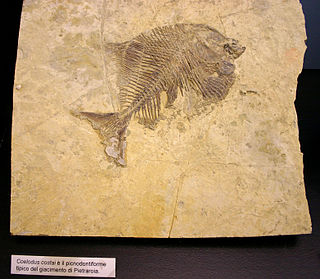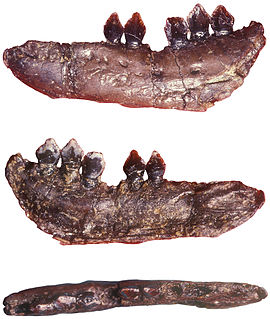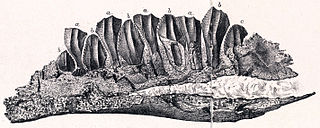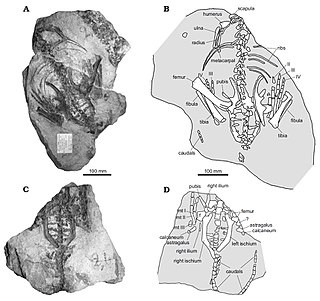 W
WAkidolestes is an extinct genus of spalacotheriid mammal.
 W
WAlgoasaurus is a genus of sauropod dinosaur from the Berriasian-early Valanginian-age Early Cretaceous Upper Kirkwood Formation of Cape Province, South Africa. It was a neosauropod; although it has often been assigned to the Titanosauridae, there is no evidence for this, and recent reviews have considered it to be an indeterminate sauropod.
 W
WArthropterygius is a widespread genus of ophthalmosaurid ichthyosaur which existed in Canada, Norway, Russia, and Argentina from the late Jurassic period to the earliest Cretaceous.
 W
WBajadasaurus is a genus of sauropod dinosaur from the Early Cretaceous epoch of northern Patagonia, Argentina. It was first described in 2019 based on a single specimen found in 2010 that includes a largely complete skull and parts of the neck. The only species is Bajadasaurus pronuspinax. The genus is classified as a member of the Dicraeosauridae, a group of comparatively small and short-necked sauropods that lived from the Early or Middle Jurassic to the end of the Early Cretaceous.
 W
WCaypullisaurus is an extinct genus of large platypterygiine ophthalmosaurid ichthyosaur from the Late Jurassic to the Early Cretaceous of Argentina. Its holotype was collected from the Vaca Muerta Formation of Cerro Lotena, Neuquen, dating to the early Tithonian stage of the Late Jurassic, about 150 million years ago. Caypullisaurus was first named by Marta Fernández in 1997 and the type species is Caypullisaurus bonapartei. It is a member of the family Ophthalmosauridae, and closely related to Platypterygius and Brachypterygius. In 2012, Caypullisaurus was found to be most closely related to Athabascasaurus and "Platypterygius" australis, and to nest within the subfamily Platypterygiinae.
 W
WCoelodus is an extinct genus of pycnodontiform fish from the Late Jurassic to early Paleocene (Danian). Fossils of the genus have been found in:JurassicGardies, FranceCretaceousYacoraite Formation, Argentina El Molino Formation, Bolivia Baharîje Formation, Egypt Ahlen and Bückeberg Formations, Germany Nimar Formation, India Alburni, Italy Damergou, Zinder, Niger Cochirleni Formation, Romania La Huérguina and Cabana Formations, Spain Pierre Shale, Kansas Tunbridge Wells Sand Formation, England Tucumcari Formation, New Mexico Twin Mountains and Paluxy Formations, TexasPaleoceneTremp Formation, Spain
 W
WCraspedites is an ammonoid cephalopod included in the Perisphinctaceae that lived during the Late Jurassic and Early Cretaceous, found in Canada, Greenland, Poland, and the Russian Federation.
 W
WCtenochasma is a genus of Late Jurassic ctenochasmatid pterosaur belonging to the suborder Pterodactyloidea. Three species are currently recognized: C. roemeri, C. taqueti, and C. elegans. Their fossilized remains have been found in the Solnhofen Limestone of Bavaria, Germany, the "Purbeck Group" of northeastern Germany, and the Calcaires tâchetés of eastern France.
 W
WEchinodon is a genus of heterodontosaurid dinosaur that lived during the earliest Cretaceous of southern England in the Berriasian epoch. The first specimens were jaw bones named Echinodon becklesii by Sir Richard Owen in 1861, and since their original description only additional teeth have been discovered. The specific name honours collector Samuel Beckles who discovered the material of Echinodon and many other taxa from across England, while the genus name translates as "prickly tooth" in reference to the dental anatomy of the taxon.
 W
WEmbasaurus is a genus of theropod dinosaur from the Early Cretaceous period. It is known from two vertebrae found in the Neocomian Sands of Kazakhstan. As it is known only from fragmentary remains, Embasaurus is considered by some to be a possible nomen dubium. It was named after the Emba River, and it is believed to have lived during the Berriasian stage, around 140 million years ago. According to the Theropod Database, a personal website designed by Mickey Mortimer, further research may suggest that Embasaurus may be a basal tyrannosauroid. George Olshevsky, however, considered Embasaurus to be a megalosaurid, closely related to Magnosaurus, Megalosaurus, and Torvosaurus.
 W
WGnathosaurus is a genus of ctenochasmatid pterosaur containing two species: G. subulatus, named in 1833 from the Solnhofen Limestone of Germany, and G. macrurus, known from the Purbeck Limestone of the UK. Its fossil remains dated back to the Late Jurassic period.
 W
WGobiconodon is an extinct genus of carnivorous mammal from the early Cretaceous. It weighed 10–12 pounds (4.5–5.4 kg) and measured 18–20 inches (460–510 mm). It was one of the largest mammals known from the Mesozoic. Like other gobiconodontids, it possesses several speciations towards carnivory, such as shearing molar teeth, large canine-like incisors and powerful jaw and forelimb musculature, indicating that it probably fed on vertebrate prey; rather uniquely among predatory mammals and other eutriconodonts, the lower canines were vestigial, with the first lower incisor pair having become massive and canine-like. Like the larger Repenomamus there might be some evidence of scavenging.
 W
WHaestasaurus is a genus of herbivorous sauropod dinosaur, belonging to the Macronaria, that during the Early Cretaceous lived in the area of present-day England. The only species is Haestasaurus becklesii.
 W
WKeilhauia is a genus of ophthalmosaurid ichthyosaur, a type of dolphin-like, large-eyed marine reptile, from the Early Cretaceous shallow marine Slottsmøya Member of the Agardhfjellet Formation in Svalbard, Norway. The genus contains a single species, K. nui, known from a single specimen discovered in 2010 and described by Delsett et al. in 2017. In life, Keilhauia probably measured approximately 4 metres (13 ft) in length; it can be distinguished by other ophthalmosaurids by the wide top end of its ilium and the relatively short ischiopubis compared to the femur. Although it was placed in a basal position within the Ophthalmosauridae by phylogenetic analysis, this placement is probably incorrect.
 W
WOwenodon is a genus of iguanodontian dinosaur known from a partial lower jaw discovered in Early Cretaceous-age rocks of Durlston Bay, Dorset, United Kingdom and also possibly known from fragmentary remains found in the Bauxite of Cornet Formation in Romania. The specimen, NHM R2998, comes from the Purbeck Limestone, dating to the middle Berriasian stage. It was first described by Richard Owen, who in 1874 assigned it to Iguanodon as the type specimen of the new species I. hoggii, the specific name honouring naturalist A.J. Hogg who had originally collected the fossil in 1860. The bone was damaged during initial preparation but was freed from the surrounding rock matrix by an acid bath between 1975 and 1977. David Norman and Paul Barrett subsequently transferred the species to Camptosaurus in 2002, but this was challenged, and in 2009 Peter Galton assigned the species to the new genus Owenodon, meaning "Owen's tooth", named after Sir Richard Owen. Galton interpreted the genus as an iguanodontoid more derived than Camptosaurus but less derived than Lurdusaurus.
 W
WPlataleorhynchus was a genus of ctenochasmatid pterodactyloid pterosaur from the Late Jurassic to Early Cretaceous periods of what is now the Purbeck Limestone of Dorset, England.
 W
WStenopelix is a genus of small marginocephalian dinosaur, possibly a basal ceratopsian, from the Early Cretaceous of Germany. It lived in the late Berriasian Stage of the Cretaceous period, approximately 140 myr ago. The genus is based on a partial skeleton lacking the skull, and its classification is based on characteristics of the hips.
 W
WTriconodon is a genus of extinct mammal from the Early Cretaceous of England and France with two known species: T. mordax and T. averianovi. First described in 1859 by Richard Owen, it is the type genus for the order Triconodonta, a group of mammals characterised by their three-cusped (triconodont) molar teeth. Since then, this "simplistic" type of dentition has been understood to be either ancestral for mammals or else to have evolved multiple times, rendering "triconodonts" a paraphyletic or polyphyletic assemblage respectively, but several lineages of "triconodont" mammals do form a natural, monophyletic group, known as Eutriconodonta, of which Triconodon is indeed part of.